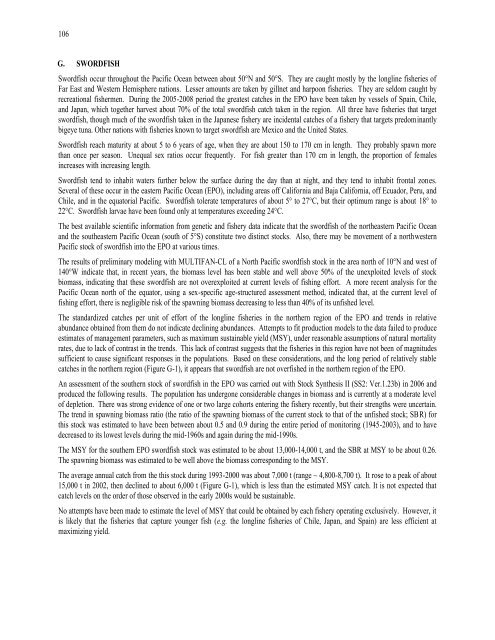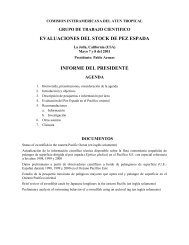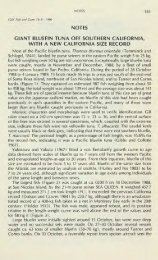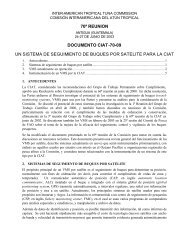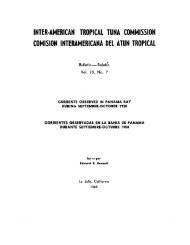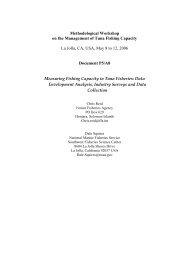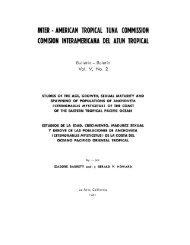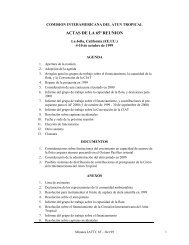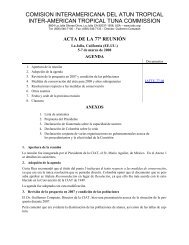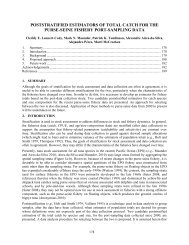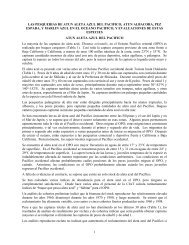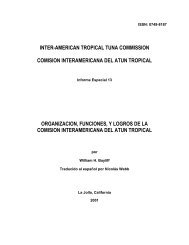IATTC Fishery Status Report 8 - Comisión Interamericana del Atún ...
IATTC Fishery Status Report 8 - Comisión Interamericana del Atún ...
IATTC Fishery Status Report 8 - Comisión Interamericana del Atún ...
You also want an ePaper? Increase the reach of your titles
YUMPU automatically turns print PDFs into web optimized ePapers that Google loves.
106<br />
G. SWORDFISH<br />
Swordfish occur throughout the Pacific Ocean between about 50°N and 50°S. They are caught mostly by the longline fisheries of<br />
Far East and Western Hemisphere nations. Lesser amounts are taken by gillnet and harpoon fisheries. They are seldom caught by<br />
recreational fishermen. During the 2005-2008 period the greatest catches in the EPO have been taken by vessels of Spain, Chile,<br />
and Japan, which together harvest about 70% of the total swordfish catch taken in the region. All three have fisheries that target<br />
swordfish, though much of the swordfish taken in the Japanese fishery are incidental catches of a fishery that targets predominantly<br />
bigeye tuna. Other nations with fisheries known to target swordfish are Mexico and the United States.<br />
Swordfish reach maturity at about 5 to 6 years of age, when they are about 150 to 170 cm in length. They probably spawn more<br />
than once per season. Unequal sex ratios occur frequently. For fish greater than 170 cm in length, the proportion of females<br />
increases with increasing length.<br />
Swordfish tend to inhabit waters further below the surface during the day than at night, and they tend to inhabit frontal zones.<br />
Several of these occur in the eastern Pacific Ocean (EPO), including areas off California and Baja California, off Ecuador, Peru, and<br />
Chile, and in the equatorial Pacific. Swordfish tolerate temperatures of about 5° to 27°C, but their optimum range is about 18° to<br />
22°C. Swordfish larvae have been found only at temperatures exceeding 24°C.<br />
The best available scientific information from genetic and fishery data indicate that the swordfish of the northeastern Pacific Ocean<br />
and the southeastern Pacific Ocean (south of 5°S) constitute two distinct stocks. Also, there may be movement of a northwestern<br />
Pacific stock of swordfish into the EPO at various times.<br />
The results of preliminary mo<strong>del</strong>ing with MULTIFAN-CL of a North Pacific swordfish stock in the area north of 10°N and west of<br />
140°W indicate that, in recent years, the biomass level has been stable and well above 50% of the unexploited levels of stock<br />
biomass, indicating that these swordfish are not overexploited at current levels of fishing effort. A more recent analysis for the<br />
Pacific Ocean north of the equator, using a sex-specific age-structured assessment method, indicated that, at the current level of<br />
fishing effort, there is negligible risk of the spawning biomass decreasing to less than 40% of its unfished level.<br />
The standardized catches per unit of effort of the longline fisheries in the northern region of the EPO and trends in relative<br />
abundance obtained from them do not indicate declining abundances. Attempts to fit production mo<strong>del</strong>s to the data failed to produce<br />
estimates of management parameters, such as maximum sustainable yield (MSY), under reasonable assumptions of natural mortality<br />
rates, due to lack of contrast in the trends. This lack of contrast suggests that the fisheries in this region have not been of magnitudes<br />
sufficient to cause significant responses in the populations. Based on these considerations, and the long period of relatively stable<br />
catches in the northern region (Figure G-1), it appears that swordfish are not overfished in the northern region of the EPO.<br />
An assessment of the southern stock of swordfish in the EPO was carried out with Stock Synthesis II (SS2: Ver.1.23b) in 2006 and<br />
produced the following results. The population has undergone considerable changes in biomass and is currently at a moderate level<br />
of depletion. There was strong evidence of one or two large cohorts entering the fishery recently, but their strengths were uncertain.<br />
The trend in spawning biomass ratio (the ratio of the spawning biomass of the current stock to that of the unfished stock; SBR) for<br />
this stock was estimated to have been between about 0.5 and 0.9 during the entire period of monitoring (1945-2003), and to have<br />
decreased to its lowest levels during the mid-1960s and again during the mid-1990s.<br />
The MSY for the southern EPO swordfish stock was estimated to be about 13,000-14,000 t, and the SBR at MSY to be about 0.26.<br />
The spawning biomass was estimated to be well above the biomass corresponding to the MSY.<br />
The average annual catch from the this stock during 1993-2000 was about 7,000 t (range ~ 4,800-8,700 t). It rose to a peak of about<br />
15,000 t in 2002, then declined to about 6,000 t (Figure G-1), which is less than the estimated MSY catch. It is not expected that<br />
catch levels on the order of those observed in the early 2000s would be sustainable.<br />
No attempts have been made to estimate the level of MSY that could be obtained by each fishery operating exclusively. However, it<br />
is likely that the fisheries that capture younger fish (e.g. the longline fisheries of Chile, Japan, and Spain) are less efficient at<br />
maximizing yield.


